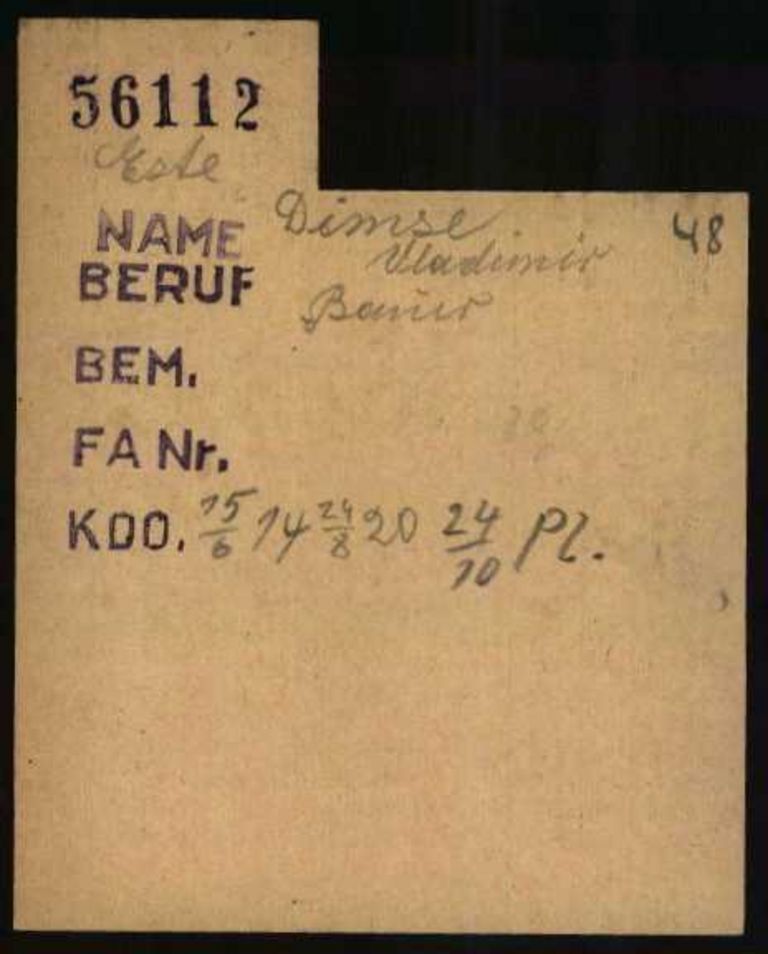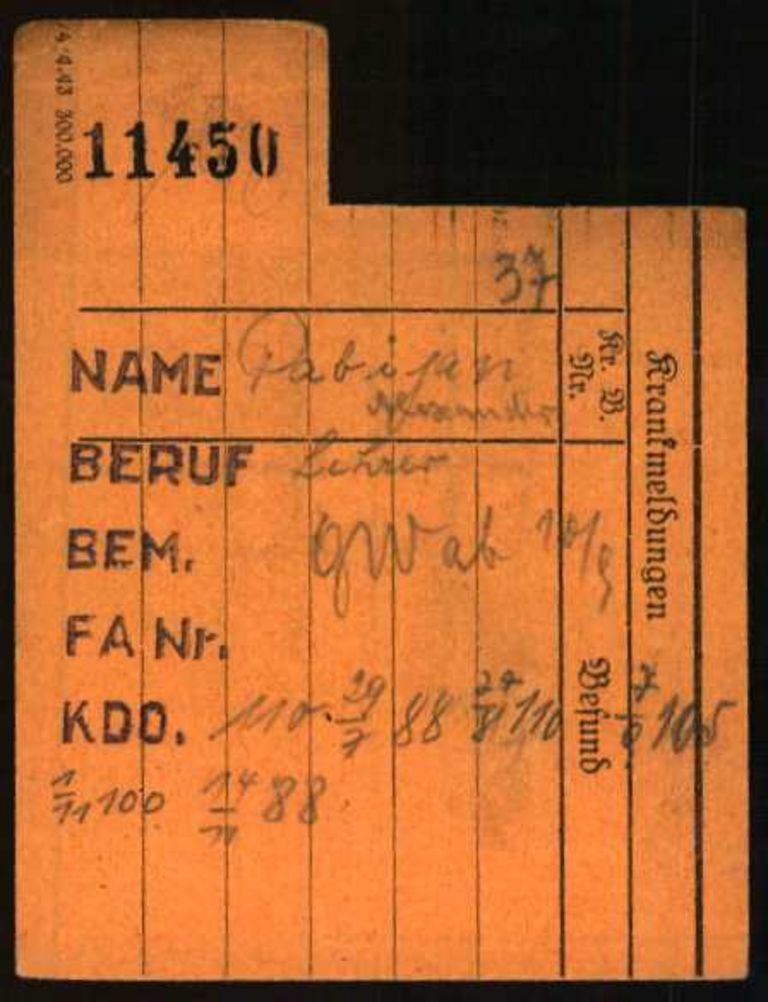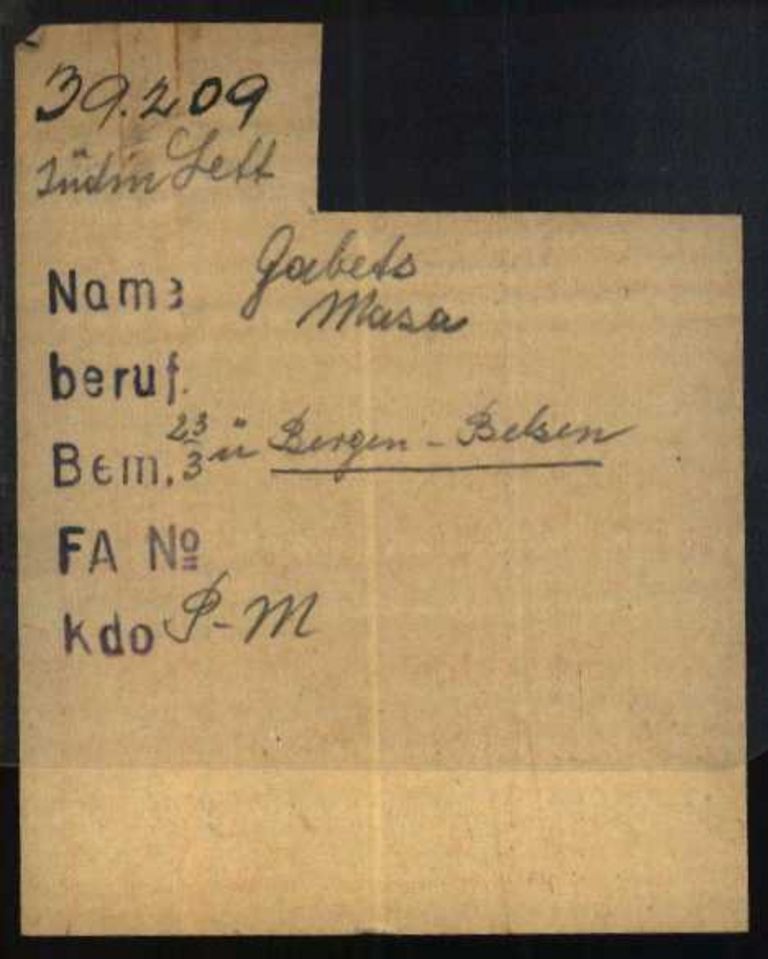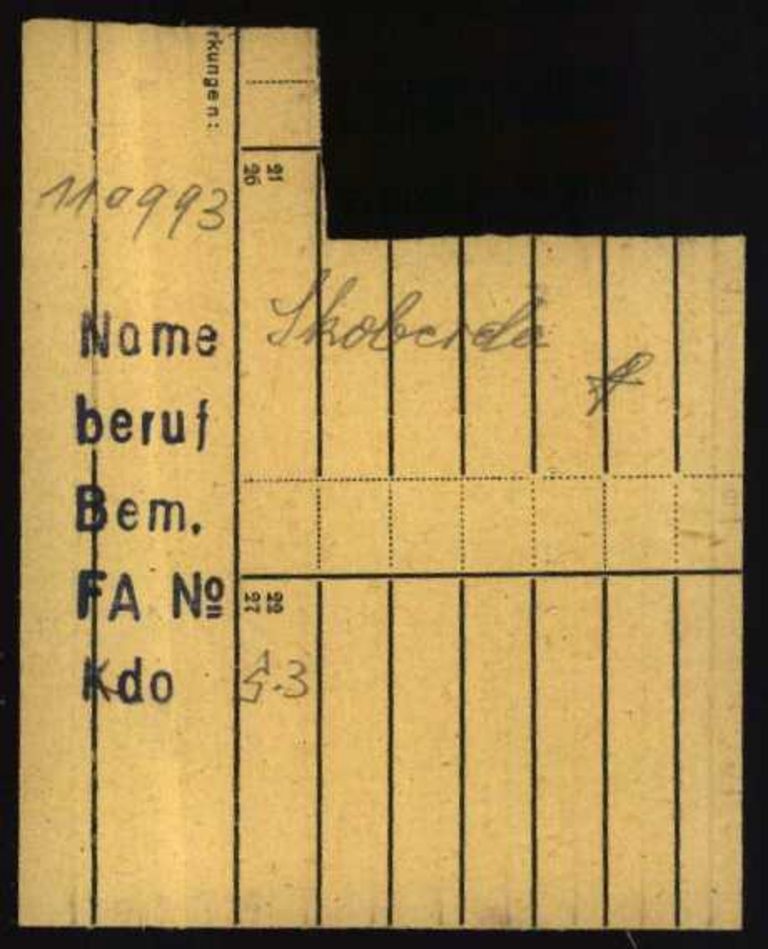Page of
Page/
- Reference
- Intro


These labor assignment cards were created in Buchenwald concentration camp. They were used to manage the labor details to which prisoners were assigned and/or in which sub-camps they were forced to work. Since the cards were always written on whatever paper happened to be available, they come in different colors. Prisoner functionaries filled out the cards using pencil, which is why some of them are difficult to read today. Under KDO. (Kommando, “detail”), any number of labor details could be listed depending on how often a prisoner was transferred. These labor assignment cards were kept for male prisoners and, from 1944, also for female prisoners who were imprisoned in Buchenwald or one of its sub-camps.
These labor assignment cards were created in Buchenwald concentration camp. They were used to manage the labor details to which prisoners were assigned and/or in which sub-camps they were forced to work. Since the cards were always written on whatever paper happened to be available, they come in different colors. Prisoner functionaries filled out the cards using pencil, which is why some of them are difficult to read today. Under KDO. (Kommando, “detail”), any number of labor details could be listed depending on how often a prisoner was transferred. These labor assignment cards were kept for male prisoners and, from 1944, also for female prisoners who were imprisoned in Buchenwald or one of its sub-camps.
Questions and answers
-
Where was the document used and who created it?
Until the early 1940s, most concentration camp prisoners did not have to work in armaments production. This fundamentally changed in 1942. The war was dragging on, and German industry was increasingly in need of labor. The Nazi regime therefore decided to use concentration camp prisoners for war production. This work was usually carried out under disastrous conditions, and many prisoners died as a result.
From March 1942, Department III E (known as Labor Assignment) and its sub-group, the Labor Statistics office, were responsible for organizing laborers in the concentration camps. The labor assignment leader (Arbeitseinsatzführer) usually supervised one or more labor service leaders (Arbeitsdienstführer) from the SS, who put together labor details along with the prisoner clerks. In Buchenwald concentration camp, four to five prisoners initially worked as clerks in the labor assignment department. Their number rose to 74 prisoners as the number of sub-camps administered by Buchenwald also increased. These clerks kept multiple card files, each of which recorded the prisoners’ occupations, names and labor assignments, respectively. Since there were no pre-printed forms for labor assignment cards, as there were for other documents, these cards were designed differently in different camps. There could be differences even within a single concentration camp. In Buchenwald, for example, the color of the labor assignment cards varies because the clerks used whatever paper was available.
- When was the document used?
From 1942, the labor assignment card file in Buchenwald held individual cards for every male prisoner who was “able to work.” Female prisoners were added only after several women’s sub-camps were placed under the administration of Buchenwald in September 1944. Various sub-camps that had previously been part of the Ravensbrück camp complex were administered by Buchenwald from that point on. Labor assignment cards were then also issued for the women in these sub-camps. Labor assignment cards were filed for male and female prisoners held in the main and sub-camps of Buchenwald until shortly before the liberation.
- What was the document used for?
In the early years of the concentration camps, prisoners usually worked in the camp’s own labor details – in the kitchen, in administrative offices or in the expansion of the camp. From 1936/1937, relatively few prisoners were assigned to the newly established SS companies in the camps or their immediate surroundings. At the time, the focus was more on harassing and terrorizing the prisoners than on economically exploiting them. By the spring of 1942 at the latest, this had changed dramatically. Oswald Pohl, the head of the SS Chief Economic and Administration Office who bore the main responsibility for the labor assignment of concentration camp prisoners, wrote to all concentration camp commandants in October 1943: “In the context of the educational mission of the early years, it might have been irrelevant whether a prisoner could perform useful labor or not. But now the prisoners’ labor is important” (1.1.0.1/82062734/ITS Digital Archive, Arolsen Archives). More and more private German businesses were lacking workers because many German men had been sent to the front lines, and even the millions of foreign forced laborers who had been brought into the country since the start of the war could no longer ensure ongoing production. At the same time, the state was massively expanding its war production through industrial groups such as the Reichswerke Hermann Göring, which meant that thousands of workers were needed for this, too. Finally, more and more companies were moving their armaments production into tunnels and caverns to protect them from aerial attack. Concentration camp prisoners first had to work on these construction sites, and later they were forced to work in production. On these construction projects in particular, their chances of survival were slim because the conditions were catastrophic.
From 1942, SS-owned firms and armaments companies established hundreds of sub-camps near their factories and construction sites. At the same time, armaments production was expanding within the camps and their immediate surroundings, where prisoners were assigned to numerous labor details. Researchers estimate that there were up to 1,000 sub-camps and labor details, with prisoners being transported back and forth between them. In mid-January 1945, there were around 714,000 concentration camp prisoners carrying out forced labor – which corresponds to an estimated 60 to 80 percent of all prisoners in total.
From March 1942, Office Group D of the SS Chief Economic and Administration Office was responsible for the labor assignment of all concentration camp prisoners, and for managing the economic connections between the concentration camps and the German economy. To make the most profitable use of the prisoners, it was important to know which special linguistic or professional skills they possessed. It was also necessary to be able to quickly identify the labor detail or sub-camp in which a prisoner was located. For this reason, various card files were kept in the labor assignment offices of each concentration camp. In addition to a card file for the prisoners’ occupations (Berufskartei) and one for their names (Namenskartei), there was a labor assignment card file with individual cards for each prisoner. The labor assignment cards from Buchenwald, which have been preserved in the Arolsen Archives, list the prisoners’ occupations as well as the labor details or sub-camps in which they were forced to work. Unfortunately, it is no longer possible to determine exactly how this card file worked; for example, we do not know whether it was used to put together labor details or just to manage them.
- How common is the document?
Labor assignment cards were filled out in all large main camps, but only cards from a few camps have been preserved in the Arolsen Archives. Most of these preserved labor detail cards were created in Buchenwald. It is not possible to say exactly how many cards are in the archive because they are scattered across the envelopes for individual documents.
- What should be considered when working with the document?
A prisoner’s living and working conditions depended heavily on the labor detail or sub-camp to which he or she was assigned. For this reason, it is important to decrypt the labor detail number or the abbreviation for the sub-camp, both of which are located in the same place on the labor assignment card. An overview of the labor details in Buchenwald and their numbers from 1943 can be found here. This information on the labor assignment cards reveals whether prisoners were assigned to the registry office or kitchen, for example, where they could spend their days in a heated room, or whether they had to carry out heavy physical labor in a sub-camp for the armaments industry, where they would be exposed to the elements. Many female prisoners in the sub-camps of Buchenwald also came into contact with dangerous chemicals that harmed their health. The labor detail or sub-camp to which a prisoner was assigned therefore always determined the prisoner’s chance of survival.
Looking at the labor assignment cards, it is apparent that in Buchenwald they were filled out with pencil. This was necessary because labor details and transfer dates could change frequently. Today it is no longer possible to read some of the cards; on certain cards the only legible information is the stamped prisoner number.
It is also important to note that the terms “labor assignment card” and “labor card” were frequently used by the ITS to refer to different card files. For example, the Arolsen Archives have cards from the Mittelbau-Dora concentration camp, as well as cards from another card file from Buchenwald, both of which were referred to internally as labor cards. Further research must be carried out to determine how these cards relate to the labor assignment cards from Buchenwald concentration camp.
If you have any additional information about this document or any other documents described in the e-Guide, we would appreciate it very much if you could send your feedback to eguide@arolsen-archives.org. The document descriptions are updated regularly – and the best way for us to do this is by incorporating the knowledge you share with us.
Help for documents
About the scan of this document <br> Markings on scan <br> Questions and answers about the document <br> More sample cards <br> Variants of the document





